Is this the most Scottish town in Italy?
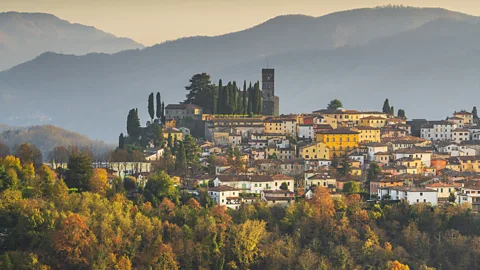 Getty Images
Getty ImagesWith deep, emotional connections to Scotland, its own tartan and a fish and chips festival, the town of Barga is an unlikely "Brigadoon" in the Tuscan hills.
In the medieval hilltop town of Barga in Tuscany's Serchio Valley, between the marble-white Apuan Alps and chestnut forests of the Apennine mountains, many things can take the unwitting visitor by surprise.
The blue and white saltire of the St Andrew's Cross, Scotland's national flag, hangs above steep, cobblestone lanes scented by wisteria. Snippets of thick Scottish accents muddle with the rhythmic flow of Italian. At the right time of year, bagpipes drone through the air. Come towards the end of January, and, if you're lucky, you'll hear the poetry of Robert Burns and get the chance to sample haggis.
Year-round, meanwhile, the Scottish staple of vigorously fried fish and chips is on the menu of local restaurants. And misty-eyed locals will not hesitate to tell you about their deep, emotional connections to Glasgow and the Ayrshire towns of Ardrossan and Largs on Scotland's west coast.
All who visit agree that Barga has a distinctive story – the local tourist board proudly proclaims it as "the most Scottish town in Italy" – and when I visited this fantasy-like "Brigadoon" to learn about its curious history, the Sun was a golden flare in the sky, the surrounding mountains sparkled and the streets were empty. The quintessential Tuscan town walls; Renaissance-era stone houses; and lemon, orange and pink villas couldn't have felt further away from the world I'd just left behind in Glasgow.
"A few years ago, we thought we'd find out how deep our connections are," said Maria Elisa Caproni, a historian and the town's librarian who had volunteered to lead me through Barga's Scottish-Italian timeline. It was a question that the town felt important to answer. "Of our 9,000 inhabitants, we calculated that about 60% have Scottish roots. It's incredible, really."
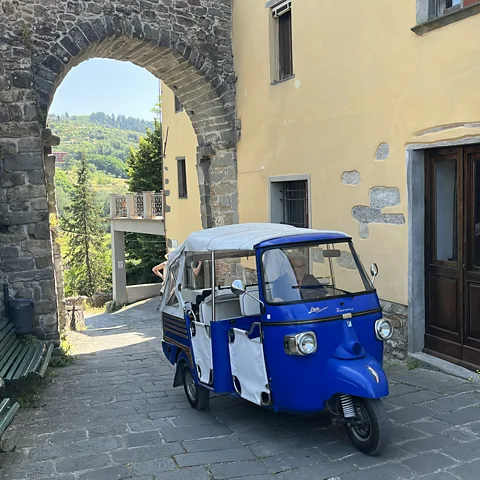 Mike MacEacheran
Mike MacEacheranLike so many other locals, Caproni has a typical story. Struggling to find work in the Serchio Valley, family on her grandfather's side migrated from Barga to Scotland in the early 20th Century. After making money in Scotland's prospering shipyards and forestry industries, many Barghese returned a few decades later, bringing a love for their adopted homeland and many of its traditions back with them. Straight away, I noticed the connections too: contemporary Scottish art here; a red telephone box there. Earlier, at the town's entrance road, I passed a sign proclaiming Barga's twinning with Prestonpans, Cockenzie, Port Seton and Longiddry – each towns located outside Edinburgh in East Lothian.
Barga was already famous – it was an essential gateway to Rome for pilgrims, merchants and traders – and has a rich history. During the Middle Ages, the surrounding cities of Lucca, Pisa and Modena fought for the town in bitter disputes, as to rule it was to control foot traffic, population flow and – crucially – taxes.
As Caproni tells it, Barga voluntarily gave itself to Florence in 1332 to guarantee its protection, yet remained far enough away from the modern-day Tuscan capital to hold onto its independence and still benefit from advantageous tax concessions. Surveying this history today is a sensory experience: the town's most magnificent building, the Duomo, or Cathedral of San Cristoforo, is a clear sign of Barga's former wealth. The colossal limestone facade is an architectural wonder, inlaid with symbols supposedly implying the presence and influence of the Knights Templar.
"Barga was a little island of Florentine power amid the hills," said Caproni, as we started our walkabout at Porta Reale gate, a liminal space between today's new town and the medieval warren of yesteryear. "But that's just the beginning of our story."
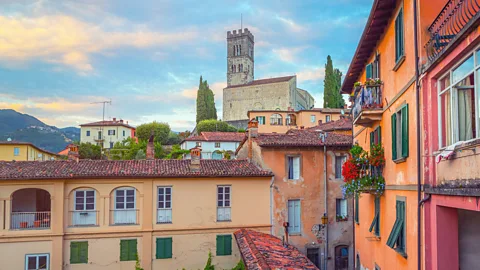 Getty Images
Getty ImagesFor five centuries under Florentine rule, Barga remained squeezed between the Republic of Lucca and the House of Este, a European dynasty with fiefdoms in today's Emilia-Romagna region, including Modena and Ferrara. Then the unification of Italy in 1861 changed everything. Following the fall of Italy's ancient city-states, Barga lost its privileges, the town's silk industry declined and waves of migration to the US and the UK began. A chief beneficiary of this Barghese labour? Scotland's west coast. Many had planned to sail to the US from there, but sufficient work saw plenty go no further on their journeys.
Soon, an influx of Italians began working along the fragmented seaboard. Then, opportunities beckoned through the opening of Italian restaurants, ice cream parlours (including Scotland's most famous, Nardini's in Largs) and fish and chip shops. Ever since, there has been a flow of people, families and stories between the Tuscan hills and Firth of Clyde coast.
A place that encapsulates this story is Giro Di Boa, a fish restaurant run by Riccardo Orsucci, originally from Barga, and his wife, Adele Pierotti, originally from Glasgow. For much of their lives, the Scottish Italian, Italian Scottish couple have been at the heart of this cross-cultural exchange, having lived, worked and brought up the next generation of Barghese Scots in both countries.
"It's common for someone to turn round and speak to you in a very clear Ayrshire or Glaswegian accent here," said Pierotti. "It can get confusing for Italians too. Sometimes, they feel like they are no longer in Italy. Sometimes, I used to think that too." The Scots' vernacular was such a dominant currency a few years ago, Caproni told me, that some shops had signs on their doors reading, "Qui si parla italiano" (Italian spoken here).
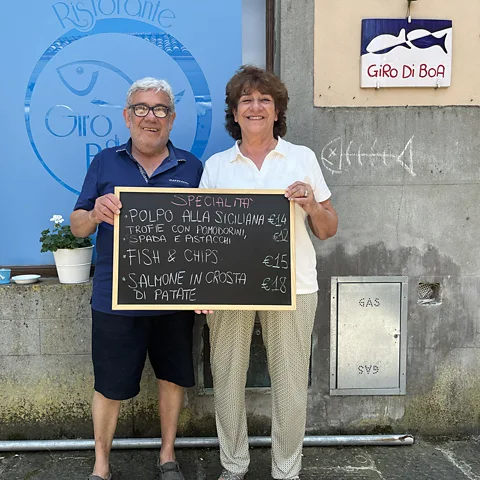 Mike MacEacheran
Mike MacEacheranOrsucci and Pierotti met in the 1970s at Glasgow's Casa d'Italia, an Italian social club for immigrants in the city's wealthy Park Circus. At the same time, Orsucci had opened a restaurant, and it was, he told me, the only Italian spot that held a traditional Burns Supper, an annual celebration of Scotland's national bard on 25 January. Now, Giro Di Boa is perhaps one of the few restaurants in Tuscany that holds a Burns Night. Certainly, it's the only one in Barga. "I like to keep these traditions alive," he said.
The chalk-written menu outside the couple's restaurant shows dishes including polpo all Siciliana (Sicilian-style octopus), spada e pistacchi (swordfish and pistachios) – and, rather conspicuously in English, fried fish and chips. These days, that meal is also the main feature of the two-week-long Sagra del Pesce e Patate (Fish & Chips Festival) for those with an appreciation of Scotland's deep-fried food culture. For two weeks each August, the town crowds around trestle tables to enjoy the simple business of paper plates loaded with crisp battered fish, fat chips, pots of mayonnaise and slices of lemon. This being Tuscany, bottles of Chianti also feature heavily. Perhaps, the feeling is that Barga's stories of migration and homecoming are best brought to life through Britain's iconic dish.
The most obvious similarity between Italy and Scotland in Barga is a shared love of good food and good times, but it is also apparent through art. That contemporary Scottish artist John Bellany, whose father and grandfather were fishermen, bought a house in Barga and was inspired by his surroundings is another breadcrumb to follow. His works are on display at the National Galleries of Scotland in Edinburgh, but his oil paintings of street scenes awash in typical Tuscan hues have also resulted in a permanent gallery opening in what became his adopted second home.
"When he arrived in Barga, his pictures exploded with colour – red, yellow and green – and it's clear the impression our town had on his creative spirit," said Caterina Campani, Mayor of Barga, whom I met later that day. "In part thanks to him, we have become a creative town of artists. More galleries open each year, and there is not only a strong emotional connection between here and Scotland but an economic one too. Many third- and fourth-generation Italian Scots have second homes now. So, Scotland is in our DNA. For us, it's a badge of honour."
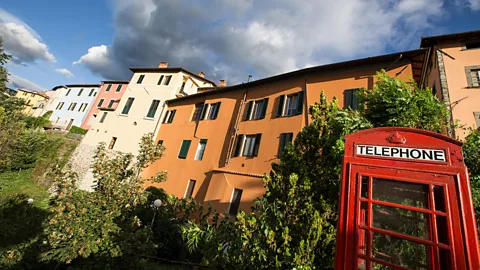 Alamy
AlamyIt would be a mistake to think the similarities between the two places end there. There's an aesthetic dimension thanks to the Barga tartan (woven in green, white and red to represent the tricolour of the Italian flag), and Italy's other religion, football, has helped further unite the Barghese with Scotland.
Outside, on a corner of Via Borgo, I found the supporters' bar of the amateur football club, the Gatti Randagi, or the Stray Cats. It's no coincidence they play in the same green and white hoops as Celtic FC, who are based in the east end of Glasgow. In years to come, the hope is that in an increasingly divided world, these bonds will grow even stronger.
--
If you liked this story, sign up for The Essential List newsletter – a handpicked selection of features, videos and can't-miss news, delivered to your inbox twice a week.
